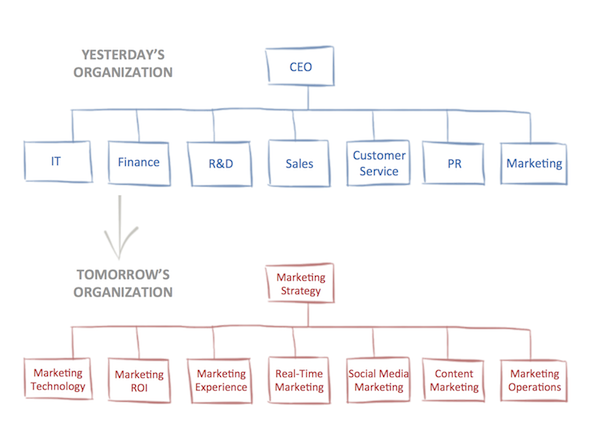Before I get an inbox full of angry emails from everyone who doesn’t work in the marketing department, let me disclaim that the above diagram was intended somewhat humorously. Hey, it’s Friday — lighten up!
But the funny thing about humor is that it often contains a nugget of truth.
Decades ago, David Packard — of Hewlett-Packard (HP) fame — declared, “Marketing is too important to be left to the marketing department.” And although marketing as a function is clearly ascendent, the scope of the marketing mission is also broader than ever too.
In an age where every touchpoint a prospect or customer has with us directly affects their perception of our brand — and can be perpetually documented and amplified in search and social media — it’s true that everything is marketing.
And it’s beyond the walls of the marketing department.
These other functions of the organization need to incorporate marketing more deeply into their worldview. And marketing needs to proactively reach across the silos and connect with them. Some of the most interesting discussions in marketing today are around better collaboration between marketing and IT, between marketing and sales, between marketing and finance, and so on.
“Which department of marketing do you work in?”




Hi Scott,
Great post! In “yesterday’s organization” I live in Marketing (more specifically Marketing Operations and Analytics), while in “tomorrow’s organization” I live in either Marketing Technology or hopefully Marketing Strategy! Have a great Friday!
Thanks, Kurt!
Robert Townsend (of Avis fame) said: “Marketing is the name of the game” and has to be done by the CEO himself.
Hi Scott! What’s the difference between marketing experience and real-time marketing?
Hi, Erica.
In this context — and again, this was just a quick sketch on a Friday for a little fun — I was thinking: product = customer experience = marketing experience. The R&D team (or whoever is developing and delivering your core product or service) takes primary responsibility for creating things that customers either love (or not).
The translation of sales = real-time marketing was from a joke I made (okay, maybe not a very good joke) that salespeople were the original real-time marketers. After all, they respond to individual customers in a very specific context. They’ve always been looking for “moments” in which to initiate a connection with a prospect.
Fun post, thx. Functionally I disagree; however, the truth is “market” sets strategy, outlines execution but everyone contributes and markets their company. Where is the customer care agent, sales person or project manager not the most critical frontline? Everyone needs to travel in the same direction. PR is a function of marketing…not seperate. I also don’t see product teams, lifecycle and all product marketing. I believe it depends significantly upon what kind of organization you are outlining. All your marketing functions are simply market communications. Where is demand generation, channel management, programs (operations?). Good fun; I suggest you keep working on your model.
Thanks, Bennet.
You bring up some very good, genuine points. I’d only spent about 5 minutes sketching for a little Friday fun. But the subject does deserve some serious attention to “connect the dots” between all these different functions in a company and the new marketing landscape. I agree, it will be a different picture for different companies though.
Nice one Scott
In tomorrow’s organisation, ‘Crowdsourced/Community marketing’ should be carved out. With the technology available and threat to current business models, its very tempting to still try and control everything in the ‘company to customer’ ecosystem.
The opportunity and threat lies in the customer to customer ecosystem – which the enterprise and marketing department needs to plan. ‘Crowdsourced/Community marketing’ is step 1, before moving it into an enterprise wide mode.
– Ramesh (Twitter @Ramesh_Ramki)
Good point.
Good thoughts and interesting vision.
I have been seeing already some of this with forward-looking B2B clients that have teams dedicated to ‘content’, ‘client experience’ and technology applied to marketing department.
Definitely the way to go. Companies might decide not to put the ‘marketing’ title everywhere but the tasks to perform are clear regardless of names and titles.
Great post. Measuring the performance of a single channel in a silo, using clickstream data, is no longer an effective way to build a brand and improve lead generation, sales and ROI.
Understanding the “whys” behind the performance of brand building and marketing campaigns requires holistic analysis – using data and behaviors to engage throughout the customer lifecycle. Every department has a piece of ownership in implementing an successful marketing.business strategy.
Good use of five minutes, Scott! Nicely thought provocative.
I’ll try to contribute: A dimension of marketing worth nothing is that it can either be to capitalize on a present perception in the market, or, to change the present perception to something that make you capitalize more in the future. It is usually different people and structures performing one or the other.
In the beginning of a company the latter rules the agenda. In a yes-we’ve-been-around-for-a-while company the first is winning the most battle of the budgets. The future of marketing will contain more organizations understanding how to handle the both parallell to each other. That, I dare to say, is not the case today. And that is why we can see younger, weaker brands accelerating past older, stronger ones more so now when fast reach can be achieved with talk value.